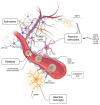The Brain Pre-Metastatic Niche: Biological and Technical Advancements
- PMID: 37373202
- PMCID: PMC10298140
- DOI: 10.3390/ijms241210055
The Brain Pre-Metastatic Niche: Biological and Technical Advancements
Abstract
Metastasis, particularly brain metastasis, continues to puzzle researchers to this day, and exploring its molecular basis promises to break ground in developing new strategies for combatting this deadly cancer. In recent years, the research focus has shifted toward the earliest steps in the formation of metastasis. In this regard, significant progress has been achieved in understanding how the primary tumor affects distant organ sites before the arrival of tumor cells. The term pre-metastatic niche was introduced for this concept and encompasses all influences on sites of future metastases, ranging from immunological modulation and ECM remodeling to the softening of the blood-brain barrier. The mechanisms governing the spread of metastasis to the brain remain elusive. However, we begin to understand these processes by looking at the earliest steps in the formation of metastasis. This review aims to present recent findings on the brain pre-metastatic niche and to discuss existing and emerging methods to further explore the field. We begin by giving an overview of the pre-metastatic and metastatic niches in general before focusing on their manifestations in the brain. To conclude, we reflect on the methods usually employed in this field of research and discuss novel approaches in imaging and sequencing.
Keywords: advanced imaging; brain metastasis; brain pre-metastatic niche; metastatic niche; pre-metastatic niche; single-cell sequencing; transcriptomics; vascular niche.
Conflict of interest statement
The authors declare no conflict of interest.
Figures



References
Publication types
MeSH terms
Grants and funding
LinkOut - more resources
Full Text Sources
Medical

